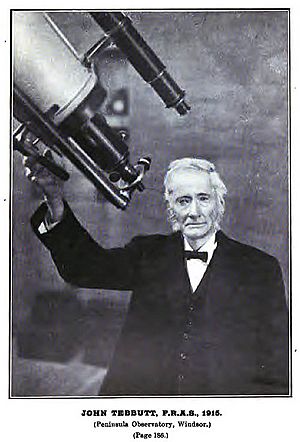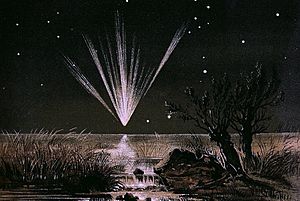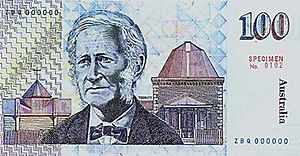John Tebbutt facts for kids
John Tebbutt (born May 25, 1834 – died November 29, 1916) was an Australian astronomer. He became famous for discovering the "Great Comet of 1861".
Contents
Early Life and First Steps in Astronomy
John Tebbutt was born in Windsor, New South Wales. He was the only son of John Tebbutt, who was a successful store owner. His grandfather, also named John Tebbutt, was one of the first settlers in Australia, arriving around 1801.
Young John went to different schools. First, he attended a Church of England parish school. Then, he went to a private school run by a Presbyterian minister. Finally, he studied at a small but excellent school where he learned Latin.
In 1845, John's father bought land in Windsor and built a house there. In 1853, John Tebbutt bought a sextant. This tool helps measure angles, especially for navigation. Using the sextant, a simple marine telescope, and a watch, he began to observe the stars and planets.
Discovering Comets and More
About nine years later, on May 13, 1861, Tebbutt made a huge discovery: the 1861 comet. This was one of the brightest comets ever seen! Back then, there was no way to quickly send news to England, where the comet became visible on June 29. John Tebbutt was recognized as the first person to discover this comet. He was also the first to figure out its path in space.
In November 1861, he bought a much better refracting telescope. It had a lens about 8.25 cm wide and was 1.2 meters long. In 1862, he was offered the job of government astronomer for New South Wales, but he chose to refuse it. He preferred to continue his own private research.
Tebbutt also discovered Nova Scorpii 1862. A nova is a star that suddenly becomes much brighter. This nova was so bright you could see it without a telescope!
Building His Own Observatory
In 1863, John Tebbutt built a small observatory with his own hands. It was near his father's house. He put his instruments inside, including his 8.25 cm telescope, a smaller transit instrument, and a special clock called a chronometer.
Around this time, Tebbutt also started recording weather observations. In 1868, he published these records from 1863 to 1866. He continued to publish these weather reports for over 30 years.
He also wrote many scientific papers. These were published in important magazines like the Monthly Notices of the Royal Astronomical Society of London. He also wrote many articles for Australian newspapers.

In 1872, he bought an even bigger telescope for his observatory, about 11.4 cm wide. In 1881, Tebbutt discovered another great comet, known as C/1881 K1. Then, in 1886, he got a new telescope that was about 20 cm wide and 2.9 meters long. This allowed him to do even more detailed observations.
He wrote a book in 1887 called History and description of Mr. Tebbutt's observatory, Windsor, New South Wales. After that, he published a yearly report about his observatory for about 15 years. Between 1868 and 1902, he made 396 observations of lunar occultation. This is when the Moon passes in front of a star or planet, hiding it from view.
Later Life and Legacy
In 1895, a local group of the British Astronomical Association was started in Sydney. Tebbutt was chosen as its first president. In 1904, when he was 70 years old, he stopped his regular work. However, he still loved astronomy and continued to observe sometimes.
The next year, the Royal Astronomical Society of London recognized his amazing work. They gave him the Jackson-Gwilt Medal, which is a very special award.
In 1908, Tebbutt published his Astronomical Memoirs. This book told the story of his 54 years of work. In 1914, a group of astronomers visited his observatory, which made him very happy. He passed away in Windsor on November 29, 1916.
The year after he died, his son gave John Tebbutt's large collection of books and writings to the State Library of New South Wales. This collection, called the John Tebbutt Memorial Collection, includes thousands of books and many volumes of his personal notes.
John Tebbutt was honored on the back of the Australian one hundred-dollar note. This note was used from 1984 until 1996.
See also
 In Spanish: John Tebbutt para niños
In Spanish: John Tebbutt para niños




